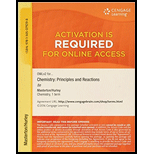
Consider the following hypothetical reaction:
R has a molar mass of 73 g/mol. When equilibrium is established, a 2.5-L reaction vessel at 125°C contains 15.0 g of R, 4.3 atm of X2, and 0.98 atm of X2R.
(a) Calculate K for the reaction at 125°C.
(b) The mass of R is doubled. What are the partial pressures of X2 and X2R when equilibrium is reestablished?
(c) The partial pressure of X2 is decreased to 2.0 atm. What are the partial pressures of X2 and X2R when equilibrium is reestablished?
Want to see the full answer?
Check out a sample textbook solution
Chapter 12 Solutions
CHEMISTRY:PRIN.+REACTIONS-OWLV2 ACCESS
- The decomposition of PCl5(g) to form PCl3(g) and Cl2(g) has Kc = 33.3 at a high temperature. If the initial concentration of PCl5 is 0.1000 M, what are the equilibrium concentrations of the reactants and products?arrow_forward12.103 Methanol, CH3OH, can be produced by the reaction of CO with H2, with the liberation of heat. All species in the reaction are gaseous. What effect will each of the following have on the equilibrium concentration of CO? (a) Pressure is increased, (b) volume of the reaction container is decreased, (c) heat is added, (d) the concentration of CO is increased, (e) some methanol is removed from the container, and (f) H2 is added.arrow_forwardShow that the complete chemical equation, the total ionic equation, and the net ionic equation for the reaction represented by the equation KI(aq)+I2(aq)KI3(aq) give the same expression for the reaction quotient. KI3 is composed of the ions K+ and I3-.arrow_forward
- At a certain temperature, K=0.29 for the decomposition of two moles of iodine trichloride, ICl3(s), to chlorine and iodine gases. The partial pressure of chlorine gas at equilibrium is three times that of iodine gas. What are the partial pressures of iodine and chlorine at equilibrium?arrow_forwardThe equilibrium constant Kc for the synthesis of methanol, CH3OH. CO(g)+2H2(g)CH3OH(g) is 4.3 at 250C and 1.8 at 275C. Is this reaction endothermic or exothermic?arrow_forwardYou place 0.600 mol of nitrogen, N2, and 1.800 mol of hydrogen, H2, into a reaction vessel at 450C and 10.0 atm. The reaction is N2(g)+3H2(g)2NH3(g) What is the composition of the equilibrium mixture if you obtain 0.048 mol of ammonia, NH3, from it?arrow_forward
- Suppose a reaction has the equilibrium constant K = 1.3 108. What does the magnitude of this constant tell you about the relative concentrations of products and reactants that will be present once equilibrium is reached? Is this reaction likely to be a good source of the products?arrow_forwardWrite an equation for an equilibrium system that would lead to the following expressions (ac) for K. (a) K=(Pco)2 (PH2)5(PC2H6)(PH2O)2 (b) K=(PNH3)4 (PO2)5(PNO)4 (PH2O)6 (c) K=[ ClO3 ]2 [ Mn2+ ]2(Pcl2)[ MNO4 ]2 [ H+ ]4 ; liquid water is a productarrow_forwardFor the reactionH2(g)+I2(g)2HI(g), consider two possibilities: (a) you mix 0.5 mole of each reactant. allow the system to come to equilibrium, and then add another mole of H2 and allow the system to reach equilibrium again. or (b) you mix 1.5 moles of H2 and 0.5 mole of I2 and allow the system to reach equilibrium. Will the final equilibrium mixture be different for the two procedures? Explain.arrow_forward
- Iodine chloride decomposes at high temperatures to iodine and chlorine gases. 2ICl(g)I2(g)+Cl2(g)Equilibrium is established at a certain temperature when the partial pressures of ICl, I2, and Cl2 are (in atm) 0.43, 0.16, and 0.27, respectively. (a) Calculate K. (b) If enough iodine condenses to decrease its partial pressure to 0.10 atm, in which direction will the reaction proceed? What is the partial pressure of iodine when equilibrium is reestablished?arrow_forwardFor the reaction N2(g)+3H2(g)2NH3(g) show that Kc = Kp(RT)2 Do not use the formula Kp = Kc(RT)5n given in the text. Start from the fact that Pi = [i]RT, where Pi is the partial pressure of substance i and [i] is its molar concentration. Substitute into Kc.arrow_forwardDuring an experiment with the Haber process, a researcher put 1 mol N2 and 1 mol H2 into a reaction vessel to observe the equilibrium formation of ammonia, NH3. N2(g)+3H2(g)2NH3(g) When these reactants come to equilibrium, assume that x mol H2 react. How many moles of ammonia form?arrow_forward
 Chemistry: Principles and ReactionsChemistryISBN:9781305079373Author:William L. Masterton, Cecile N. HurleyPublisher:Cengage Learning
Chemistry: Principles and ReactionsChemistryISBN:9781305079373Author:William L. Masterton, Cecile N. HurleyPublisher:Cengage Learning Chemistry: The Molecular ScienceChemistryISBN:9781285199047Author:John W. Moore, Conrad L. StanitskiPublisher:Cengage Learning
Chemistry: The Molecular ScienceChemistryISBN:9781285199047Author:John W. Moore, Conrad L. StanitskiPublisher:Cengage Learning ChemistryChemistryISBN:9781305957404Author:Steven S. Zumdahl, Susan A. Zumdahl, Donald J. DeCostePublisher:Cengage Learning
ChemistryChemistryISBN:9781305957404Author:Steven S. Zumdahl, Susan A. Zumdahl, Donald J. DeCostePublisher:Cengage Learning Chemistry: An Atoms First ApproachChemistryISBN:9781305079243Author:Steven S. Zumdahl, Susan A. ZumdahlPublisher:Cengage Learning
Chemistry: An Atoms First ApproachChemistryISBN:9781305079243Author:Steven S. Zumdahl, Susan A. ZumdahlPublisher:Cengage Learning
 Chemistry for Engineering StudentsChemistryISBN:9781337398909Author:Lawrence S. Brown, Tom HolmePublisher:Cengage Learning
Chemistry for Engineering StudentsChemistryISBN:9781337398909Author:Lawrence S. Brown, Tom HolmePublisher:Cengage Learning





